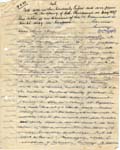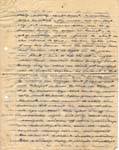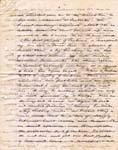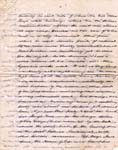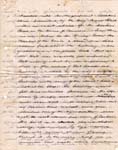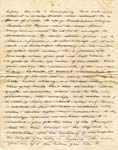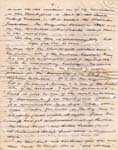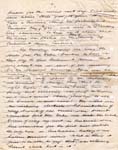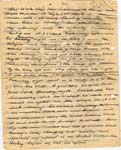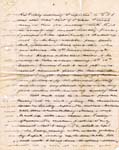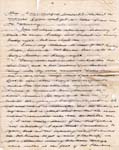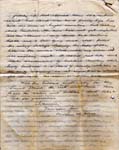ACT Heritage Library Manuscript Collection
HMSS 0271 William Glover Letter from Canberra 1927
Scope and Content Notes
|
Call Number |
HMSS 0271 |
|
Collection |
William Glover Letter from Canberra 1927 |
|
Date Range |
1927 |
|
Quantity |
1 copy (on file) |
|
Access Conditions |
open |
|
Copying Conditions |
with attribution |
|
Related Collections |
|
William Allison Glover (8 June 1906 - 16 July 1988), known as Bill, was born in Victoria and educated at Ballarat High School. He graduated with a Bachelor of Science from the University of Melbourne in 1927, also completing a Diploma of Education there in the same year. His professional career was mainly as a science teacher and as the principal of a training farm for underprivileged youths.
As a member of the Melbourne University Rifles (later Melbourne University Regiment), Bill travelled to Canberra in May 1927 to attend the opening of Parliament House.
This letter, written from Melbourne to his parents in Ballarat, is an eyewitness account of the transfer of the seat of government from Melbourne to Canberra, and a description of the young capital city of Australia.
The annotation on the first page of the letter is by Bill's wife in 1988.
We are grateful to Bill's daughter, Alice Glover, for the donation of the scans of this letter.
|
199 Drummond St
Dear Mum and Dad My pen moves automatically at present on the word 'Go'. All yesterday for seven solid hours, I copied up lectures and prepared teaching notes. The only disadvantage of being away for a fortnight is the amount of work to be made up afterwards. I have got so much to tell you that I don't quite know where to begin. Let us do Canberra first. I left last Monday week in a special military train at 6.30 for Canberra. We had plenty of room in our carriage and a very pleasant journey as far as Albury. At Seymour we had tea at 9 o'clock and reached Albury at 12.15. We changed over into the waiting N.S.W. train and our particular party had a compartment to ourselves - seven men - the two officers of course travelled first class. But oh! what a train!! Never again shall I complain of Victorian Railways. A narrow, dirty, smelly compartment; a window ledge on which a fly could sit comfortably but which was as little use to a human being as snow in harvest; a set of windows which refused to shut or else refused to open; electric lights - one of very low power and the other may have been electric but no light as globe was phut; and to top the lot a night whose temp. reached below freezing point. The only way we could get any sleep was to huddle together on one seat and that was not very satisfactory. We finally ended by clearing one luggage rack of equipment and taking it in turns to sleep up there. It had the disadvantage that one arm invariably went to sleep before you did and the rack was too narrow to alter one's position, but at least we could stretch our legs up there. Well after a very uncomfortable night broken by short halts at wayside stations of which advantage was taken to get either some hot coffee or some running exercise, we reached Goulburn at 10 o'clock Tuesday morning. After a scrappy, badly organized breakfast we switched over on to the branch line to Canberra and arrived at Eastlake [Now Kingston] - the present railway terminus - about 1.30 or a little later. We then formed up and marched the 3 miles or so to our camp. The first glimpse of Canberra is disappointing. One sees a house here, a cluster of houses there, a big building on the top of a hill some distance off and various scattered landmarks like steam rollers, a labourer actually working on a clump of trees. One begins to ask - Where is Canberra? But it is a country of surprises. There are numerous low foothills and one never knows what is over the crest of the next rise. It may be another suburb or only a creek spanned by a bridge. Well on the way out to camp we began to pick out various features - leaving Eastlake, a big shopping centre - we passed along a well made road to a line of straggly but well-built rather nice houses. This we learnt afterwards was Blandfordia the aristocratic part of Canberra. We climbed the next hill and got our first glimpse of Parliament house - a beautiful white building on each side of which are two other large white buildings which are the federal administrative offices. The next rise showed us our camp, erected on the side of a hill and in a very convenient place from which to reach various points of interest. After some more faulty administration at Headquarters we eventually got settled for the night. In the morning I had a cold shower at 6.15 reveille and then began our week's work. It was no easy camp - certainly not a sightseeing one. We were kept hard at it the whole time - practising rifle exercises and ceremonial, rehearsing various features of the review or other parts of the programme, and altogether spending a very strenuous week. Our evenings were free and on Wednesday evening a military party was shown over portions of Parliament House. I joined that party and saw the beautiful King's Hall with the bronze statue of King George (later unveiled by the Duke), round the walls busts of the leading men in the first Federal Parliament, and other historic souvenirs. Off King's Hall opens the House of Reps. - a beautiful chamber with its magnificent Speaker's Chair presented by the King to our Parlt. It is an exact replica of the Speaker's Chair in the House of Commons. From there we were taken to the Dining Room for Members of the House and there we were told various facts about the building - all of which are in the guide book. That was all that was available for inspection that evening, but it was sufficient to show us the nature of that wonderful building - which by the way is only a temporary one. Thursday night I went into Eastlake with some of the others and had a look at the shops. On Saturday was a full dress rehearsal followed in the afternoon by a rifle match between the units assembled in the camp. While waiting for our turn to shoot some of us climbed one of the big mountains near and got a most wonderful view of Canberra. It is built in a saucer shaped valley, surrounded by high wooded hills with several streams flowing through it. In the valley itself are numerous low crests which I mentioned before. The city is beautifully laid out and when it is a city proper will indeed be a cause of pride for every Australian citizen. Parliament House can be seen from everywhere and as it will always be surrounded by open spaces given up to lawns and gardens, it will always so stand out - a beautiful building in the centre of what will indeed be a garden city. It is only when you get up high above it and get a bird's eye view of the place that you realize the immensity of the undertaking. Suburbs at present represented by groups of houses or in some cases by a little town already, are dotted everywhere. When you think that over an area approx. 9 miles in diameter which will be the city of Canberra, all sewerage and water supply is already laid on and that when any house is erected it can be at once supplied with water, electric light and connected to the sewerage system no matter where it is erected, you get an idea of the foresight which has been shown in the layout and preparation for the building of our capital. The longer you stay in Canberra and the more you see of it the better you like it. It is a city wonderful in conception and great in execution. As the policy is to allow no deviation however small from the plans as first prepared, we may certainly hope to see here in Australia the perfectly planned and built city. On Sunday we had a church parade on the site of the permanent Parliament House. Among the chaplains officiating were the Bshp. of Goulburn - Dr. Radford - and the Rev. John Walker. I had previously met the Bishop at an early Communion Service in Camp - the first communion service in the Federal Territory on that day. I introduced myself to him knowing his son Paul very well - we were both at Trinity and in fact the way we have crossed each others paths is a story I'll tell you some day - it must be more than coincidence. In the afternoon I went with another chap on a ramble round the district taking cameras. We visited the old Church of England Church - St John the Baptist Church - the oldest building in the Federal Territory. It is rather a wonderful old Church and one of the most wonderful things about it is the old church yard round the Church as was the old custom; one of the tombstones in this Church yard is that of Mrs. Sarah Webb of Uriarra. It is called the Prophet's Tombstone. The lady was buried in 1845 and on her tombstone - the fourth oldest there - is this inscription “For here we have no continuing city but hope for one to come.” We then left the Church and walked over the future site of the Canberra Gardens. From here one gets a splendid view of the “Capitol” with its surrounding buildings. We could also see from there the crowd of people gathered for the Dedication of the Site of the Anglican Cathedral. It is on the adjoining hill to the Parliament House and is one of the picked sites of the district. When the cathedral is built it will be one of the most outstanding landmarks of the countryside. At present it is surmounted by a large white stone cross visible for miles in the day time and lit up by flood lights at night. From here one can get a splendid view of Eastlake, the Power House, the Public School, and of Parliament House from still a different angle. We went into Eastlake for tea and then back to camp for a “spit and polish” parade for the review next day. I also wrote some letters. I hope you got yours. It should have a Canberra stamp on postmarked “Canberra May 9th 1927” and will be a rather nice souvenir to keep as it shows that the letter was posted on the day of opening of Parliament House, Canberra. On Monday morning we lined the route for the Duke and Duchess to pass on their way to open Parliament House. That was about all we saw of the ceremony. In the afternoon however there was the military, naval and air review - a magnificent site only spoilt by the distressing air accident. A strange thing that the night before, the airman Ewen, had the feeling that something was going to happen and went round and bade goodbye to all his friends in our camp! The review was an inspiring spectacle. Representatives of every branch of the service were present and marched past the Duke who took the salute. Colours of every regiment in Australia were here assembled for the first and perhaps the only time in Australian history - an historic occasion indeed. What a thrill it gives to be able to say that one was actually present and took part in it! After it was over we returned to Camp and from then on it began to break up. Some units left 3 o'clock Tuesday morning, others later in the day, still others Wednesday morning and the unlucky Victorians last of all at 6 o'clock Wednesday afternoon. On Monday night we (the M.U.R.) were the fatigue unit appointed to help the quartermaster collect blankets of those troops who were leaving. So we got little sleep that night. Tuesday night we got a regular torrential downpour and the camp was flooded. By the time all was ship shape for the night it was pretty late so again little sleep. Wednesday night we spent in a nasty N.S.W. train - still less sleep. So you can imagine how tired I felt Thursday night. I rolled into bed immediately after tea about 7 o'clock and never moved one eyelid till John [His brother] called me at 8.15 next morning. On arrival Thursday afternoon we marched back with our Colours and were dismissed after the most historic camp it will ever be my privilege to attend. Thursday afternoon - what was left of it - was spent having a bath, changing into civvies and reporting my return to the proper authorities. Friday began the old life again. On Friday morning I reported to U.H.S. and was told that if I liked I could carry on there for another week to fit in some of my missed teaching practice. I jumped at the opportunity and started off well by taking a double prac. period that afternoon - Quick work this when you observe the 3rd period, during 4th period prepare a practical lesson and be ready to take a class during 5th and 6th periods. However I did it and got an excellent comment from the teacher. The lesson I taught before leaving for Canberra was criticized by Mr. Sharman himself and he was very pleased and gave me a very good written criticism in my teaching book. Next week will be a rush pour moi. Teaching all the week; giving the discussion lesson on Tuesday before the method lecturer and all those students doing Science; and to end up with an exam on Friday afternoon the existence of which I only learned last Friday. Oh what a life! All Friday evening and the whole of Saturday I spent writing up lecture notes. All next week I shall have to spend swotting them. A very cheerful prospect! So don't be surprised if you don't get a letter from me on Wednesday. John and I shall be returning Saturday. I think the exam Friday will prevent us coming Friday night but we shall see. I was very shocked to hear of Mr. Baxter's death. I wrote to Mrs. Baxter Senr. and to Mr. George Baxter on Friday night. I have collected various match box tops for Tom and a few pictures for Isabelle along with my other souvenirs. I also have one or two other things which I got at Canberra. I got a nice little bronze ash tray with match box holder attached engraved with a picture of Parliament House, Canberra as a little souvenir for myself to keep on my desk or table wherever I may be. It cost me 3/6 - a sum which is reasonable for the article at any time but is cheap when one has the associations connected with this particular one. I still recall phases of the trip which are interesting. I don't think I mentioned to you that on the Saturday when I climbed up Mt Ainslie to get a view of Canberra, we got a splendid view of Duntroon College which nestles at the foot of Mt. Pleasance. Also on the Monday morning a guard of honour of Duntroon cadets marched past us as we were lining the route and I saw Colin Christie amongst them. I also met Hugh Montgomery who was with the Artillery units, and Harry Gough who was the officer in charge of the 8th Battalion Unit from Ballaarat. I met several others whom I knew including Rev. Thomas - the Scout Padre from Burnie, Tas - the clergyman with whom Sister Agnes stayed when she was over for her holiday in Tas. Last January. I also met among the Scouts “Chicken” Forsythe and Eddy Brown - the latter an old St. Peter's boy whom I taught in my Sunday School class. Also I don't think I mentioned there was ice on the washing trough every morning and one night when we had a heavy frost I slipped on the ice covering the foot boards under the showers - and still I never got a cold or anything wrong. One of the most beautiful sights I've ever seen was the view one morning from our camp over towards the east. The clouds had come down during the night, but the sun getting up had cleared them to a certain extent. Our camp was on a fairly high hill and we were in bright sunshine. But looking over Canberra the sun had not yet dispelled all the clouds - only down to a certain depth and the low lying mist still filled the many valleys leaving the tops of the hills in the saucer clear while all around was swirling mist. It looked just like dark rocks surrounded by breakers curling white. Truly Canberra is a place of beauty whether in the early morning or at sunset - a wonderful spectacle the sunsets at Canberra. Well I've babbled sufficiently for the present I think. The rest will keep. Love to all the sisters and brother and lots and lots for yourselves I remain, Your affect. son William A. Glover. |
|


